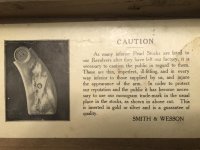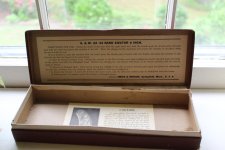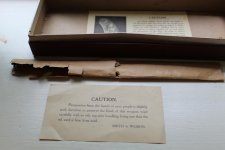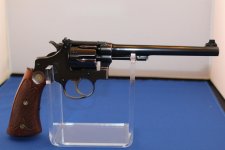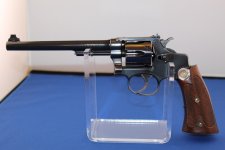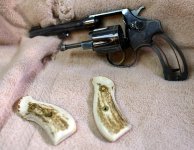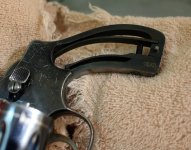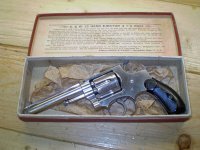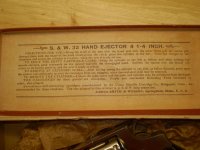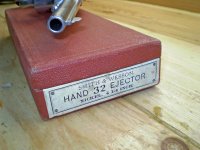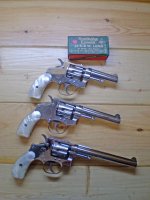Teddydog
Member
A couple weeks ago I bought my first 1st Model Hand Ejector .32, or Model 1896. And here I present it to you. Very happy to have this representative of the first generation swing-out cylinder Smith & Wesson.
The revolver is in .32 S&W (aka .32 S&W Long) and has a 3 1/4" barrel and blued finish. Heavy finish wear, but still nice enough in places to make it difficult to photograph without getting reflections of myself or the camera in the pictures! SN is 12465, so I'd guess around 1900 (a bit over 19,000 made between 1896 and 1903). This SN is on the butt, cylinder face and bottom of the barrel.


Different from most S&W revolvers, the 1896 does not have a thumb latch to open the cylinder. Instead, the head of the ejector rod is pulled forward to open the latch so the cylinder can swing open to the left.


The cylinder stop also comes in from the TOP of the frame rather than the bottom, and because of this the rear sight is located near the front end of the frame. The cylinder stop is spring loaded and is pushed up by a lever on the firing pin tip as the hammer is drawn back, releasing the cylinder to turn. When the hammer moves forward to fire, rather than push the stop up again, small fingers move outward to allow the hammer and firing pin to seat fully and fire the gun. Very interesting design to observe!


It is wearing what I am sure are genuine Mother of Pearl grips. They don't fit all that well and have a crack or two and a small chip, but probably have been on this gun for a very long time. First genuine MOP grips I have owned...they are very interesting! Dense and heavy for their size and quite hard.

Here it is with a late 1930's Regulation Police.

Any and all comments are welcome.
Rob
The revolver is in .32 S&W (aka .32 S&W Long) and has a 3 1/4" barrel and blued finish. Heavy finish wear, but still nice enough in places to make it difficult to photograph without getting reflections of myself or the camera in the pictures! SN is 12465, so I'd guess around 1900 (a bit over 19,000 made between 1896 and 1903). This SN is on the butt, cylinder face and bottom of the barrel.


Different from most S&W revolvers, the 1896 does not have a thumb latch to open the cylinder. Instead, the head of the ejector rod is pulled forward to open the latch so the cylinder can swing open to the left.


The cylinder stop also comes in from the TOP of the frame rather than the bottom, and because of this the rear sight is located near the front end of the frame. The cylinder stop is spring loaded and is pushed up by a lever on the firing pin tip as the hammer is drawn back, releasing the cylinder to turn. When the hammer moves forward to fire, rather than push the stop up again, small fingers move outward to allow the hammer and firing pin to seat fully and fire the gun. Very interesting design to observe!


It is wearing what I am sure are genuine Mother of Pearl grips. They don't fit all that well and have a crack or two and a small chip, but probably have been on this gun for a very long time. First genuine MOP grips I have owned...they are very interesting! Dense and heavy for their size and quite hard.

Here it is with a late 1930's Regulation Police.

Any and all comments are welcome.
Rob


